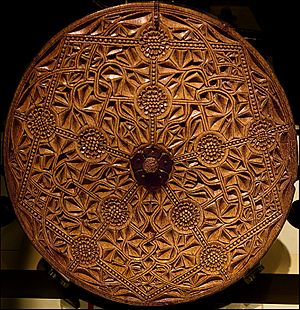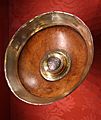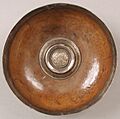Mazer (drinking vessel) facts for kids


A mazer is a special kind of wooden cup used for drinking. It's a wide, shallow bowl without handles. Inside, it has a small knob or bump called a "boss." Mazers were made from strong woods like maple, beech, and walnut. Some were plain wood, while others were decorated with fancy metal, often silver. People in northern Europe used them a lot from the 1100s to the 1500s.
Contents
What's in a Name?
The word mazer comes from old European languages, like Middle English and Old French. These words came from an even older German word, *masuraz. This word meant "a knot or swelling of a tree," especially referring to the curly grain found in maple wood. So, the name "mazer" probably comes from the special wood used to make these cups.
What Mazers Looked Like
The mazers we still have today are usually the most expensive ones. They often have large silver decorations. But old digging sites have found many plain wooden mazers. These were probably the most common ones back then. For example, many simple mazers were found in the wreck of the Mary Rose ship.
Mazers are usually about 5 to 11 inches wide. The fancy ones often have a metal rim, usually made of silver. The foot and the boss (the knob inside) were also often metal. Some mazers even had wooden lids, sometimes with a metal handle. The Bute Mazer is a good example of this.
Often, the metal rim had writing on it, like religious sayings or friendly messages. The boss in the middle was also often decorated. It might have a sculpted picture, an engraving, or even a gem. The Bute Mazer has a detailed lion sticking up from its base. It also has colorful family symbols around it. Other common decorations on the boss included saints, religious letters like IHS (for Jesus), or animals. These animals often had special meaning for families.
Some later mazers had a stem, like a modern cup. This might have been to copy other fancy cups of the time. After the 1500s, mazers were still made, but they were more like traditional items. Today, some woodturners and silversmiths still make mazers.
The best mazers were made from special burr maple wood. This wood has a unique, swirly pattern. Both the wood and the cups made from it were called "mazer." The finest mazers had silver or gold-plated silver rims added. Often, a decorated disc called a "print" was added to the base of the bowl. Sometimes, a silver foot was added too, especially on later mazers.
How Mazers Were Used
The size of wooden mazers was limited by the size of the trees they came from. Adding a metal rim could make a mazer hold twice as much liquid. Large, decorated mazers were probably passed around a table for toasts, like fancy punch bowls. But simpler ones might have been personal cups for people in a household or a monastery. Important people would have used the fanciest ones. Old records show that many mazers were even given names!
In a monastery in Durham, each monk had his own mazer with a silver rim. They also had a very large mazer called the "Grace cup," which was passed around after meals. Another special one, the "Judas cup," was only used on Maundy Thursday. Sometimes, churches were given mazers. They would use them at church parties and other events.
Fancy mazers were often listed in people's wills and inventories. In 1395, a man named John de Scardeburgh left 12 mazers when he died. Four years later, the King of England, Henry IV of England, only had 10 mazers listed in his treasures! But monasteries could have many more. For example, Canterbury Cathedral had an amazing 132 mazers in 1328.
Mazers You Can Still See Today
More than 60 medieval British mazers are still around. Many of the English ones were kept safe in old colleges like Oxbridge universities, special clubs called livery companies, and hospitals. These places have existed since the Middle Ages. Not many mazers were passed down through wealthy families, even though rich families owned them back then. The Bute Mazer is one of the few exceptions.
One mazer still belongs to All Souls College, Oxford. It was given to the college in 1437. Another example is the Swan Mazer at Corpus Christi College, Cambridge, from the late 1300s. This mazer has a swan on a thin column in the middle. If you fill it too full, the drink runs down the column and out of the foot! This was probably a trick played on new students.
Over time, mazers changed. Older ones were deep bowls with narrow rims. Later ones became shallower with much wider rims. In the 1200s and 1300s, rims were simple and plain. But in the 1400s and 1500s, rims became very deep (about 3-4 cm) and often had letters on them. You can see a good collection of mazers at the Museum of Canterbury. They have ten mazers from the 1200s and 1300s on display.
A very beautiful mazer from France or Flanders is in the British Museum. It's from the early 1400s. It has a very thin wooden bowl and amazing silver decorations, including colorful enamel. This mazer even has its original leather travel case!
Images for kids
-
A mazer from Britain, 15th-century, at The Cloisters museum.
-
A modern mazer made from rowan wood and silver by Robin Wood.







